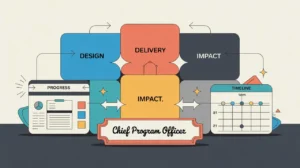What Does the Executive Director Role Involve?
An executive director is responsible for providing overall leadership, strategic direction, and operational oversight for an organization. This includes setting vision and strategy, managing executive teams, ensuring financial sustainability, building partnerships, and representing the organization externally. The role typically sits at the apex of the organizational structure, reporting to the board of directors, and working across all functions to align programs, operations, fundraising, and communications with the organization’s mission and strategic goals. In both nonprofits and social enterprises, executive directors are pivotal in driving impact, ensuring accountability, and guiding the organization through periods of growth, change, and adaptation.
At What Level does this Role Operate?
Executive Level: This role reports directly to the board of directors and has authority over senior leadership and management teams. It involves shaping strategic vision, stewarding organizational culture, and ensuring that strategy, operations, and resources are aligned for long-term sustainability.
Relative Employability: Executive director roles are highly competitive and typically require a blend of strategic leadership, sector expertise, and management experience. Demand is steady across nonprofits and social enterprises, particularly in organizations experiencing growth, transition, or strategic repositioning.
Relative Pay Scale: Within nonprofits and social enterprises, executive director roles sit at the top of the pay scale, reflecting their leadership responsibilities, decision-making authority, and organizational accountability.
What are the Key Responsibilities and Activities?
- Develop and lead the organization’s strategic direction in collaboration with the board and senior leadership
- Manage senior leadership teams and ensure functional alignment across programs, operations, finance, and communications
- Oversee financial strategy, budgeting, and resource mobilization to ensure sustainability and growth
- Build and maintain strong relationships with partners, funders, stakeholders, and communities
- Represent the organization publicly, serving as a primary spokesperson and thought leader
- Ensure compliance with legal, regulatory, and governance requirements
- Cultivate an organizational culture that aligns with mission and values
- Guide organizational change, innovation, and adaptation to evolving contexts
- Report to and collaborate closely with the board of directors to ensure effective governance
What Core Competencies and Qualifications are Needed?
Required Qualifications and Experience
The following reflect common qualifications and experience expected for this role, while recognizing that pathways may vary by context, organization, and region.
- Significant leadership experience in nonprofit, social enterprise, or related sectors
- Proven track record in strategy development, organizational management, and financial stewardship
- Deep understanding of governance, fundraising, and partnership development
- Strong communication and relationship-building skills with diverse stakeholders
- Experience managing senior teams and navigating complex organizational environments
- Academic qualifications in management, public administration, social sciences, or a related field are often preferred but not always required
Key Competencies
- Strategic vision and leadership
- Organizational and financial management
- Governance and board relations
- External representation and partnership development
- Culture building and change leadership
- Decision making and accountability
How are AI and Automation Shaping this Role?
An AI-native executive director will look to AI and automation to strengthen decision making, improve organizational efficiency, and expand strategic foresight. They can use AI tools to analyze financial and operational data, track program performance, and identify trends that inform strategic pivots. Automation can support reporting to boards and funders, streamline administrative functions, and optimize internal communication systems. By leveraging these technologies, executive directors can dedicate more time to high-level strategy, external relations, and adaptive leadership.
What Career Pathways and Transferable Skills are Associated with this Role?
Executive director roles can lead to positions such as CEO of larger organizations, senior roles in philanthropy or international NGOs, or board leadership positions. The skills developed in strategy, governance, organizational management, and partnership building are highly transferable across sectors, including public service, corporate leadership, and academia. This role represents the pinnacle of leadership within nonprofits and social enterprises, providing a platform for broad influence and impact.







